
College Thesis
This is where my speculative biology project started to become more serious. Over the course of about 5 months I made 6 pieces, each a small part of the larger world.
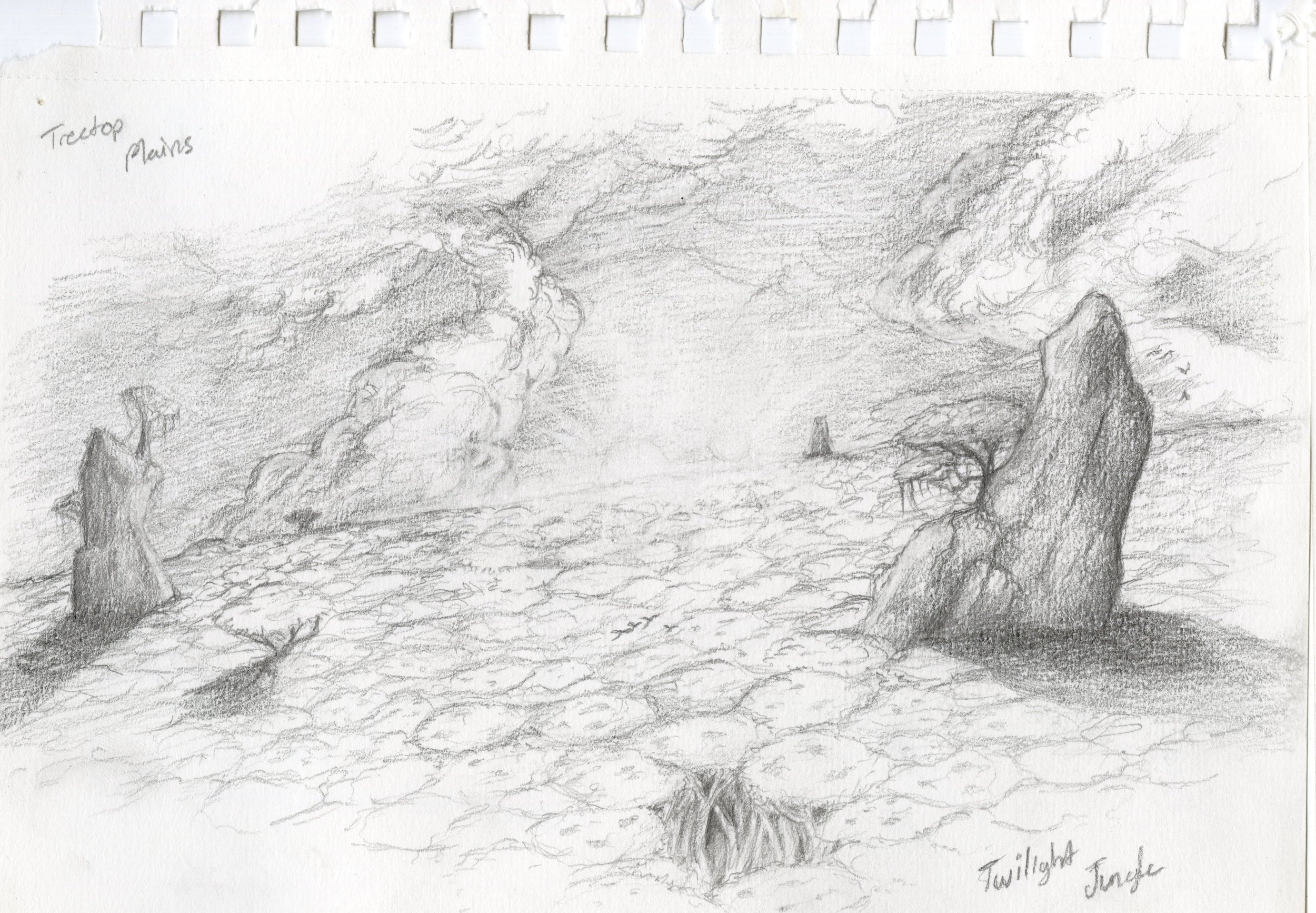
Piece 1: Canopy Marsh
36” x 11” Digital Panoramic Painting
This was the largest, and most ambitious piece in the collection I made for my thesis. It was my final work, and the “magnum opus” of the 5 months spent.
In totality, this piece took around 40 hours. After an initial 14 hours of painting into the first version, I scrapped it and restarted, thus becoming the rendition you see here.
This piece, and all the others I made for my thesis, helped me realize how much I enjoy creating the environments my creatures & characters live in.
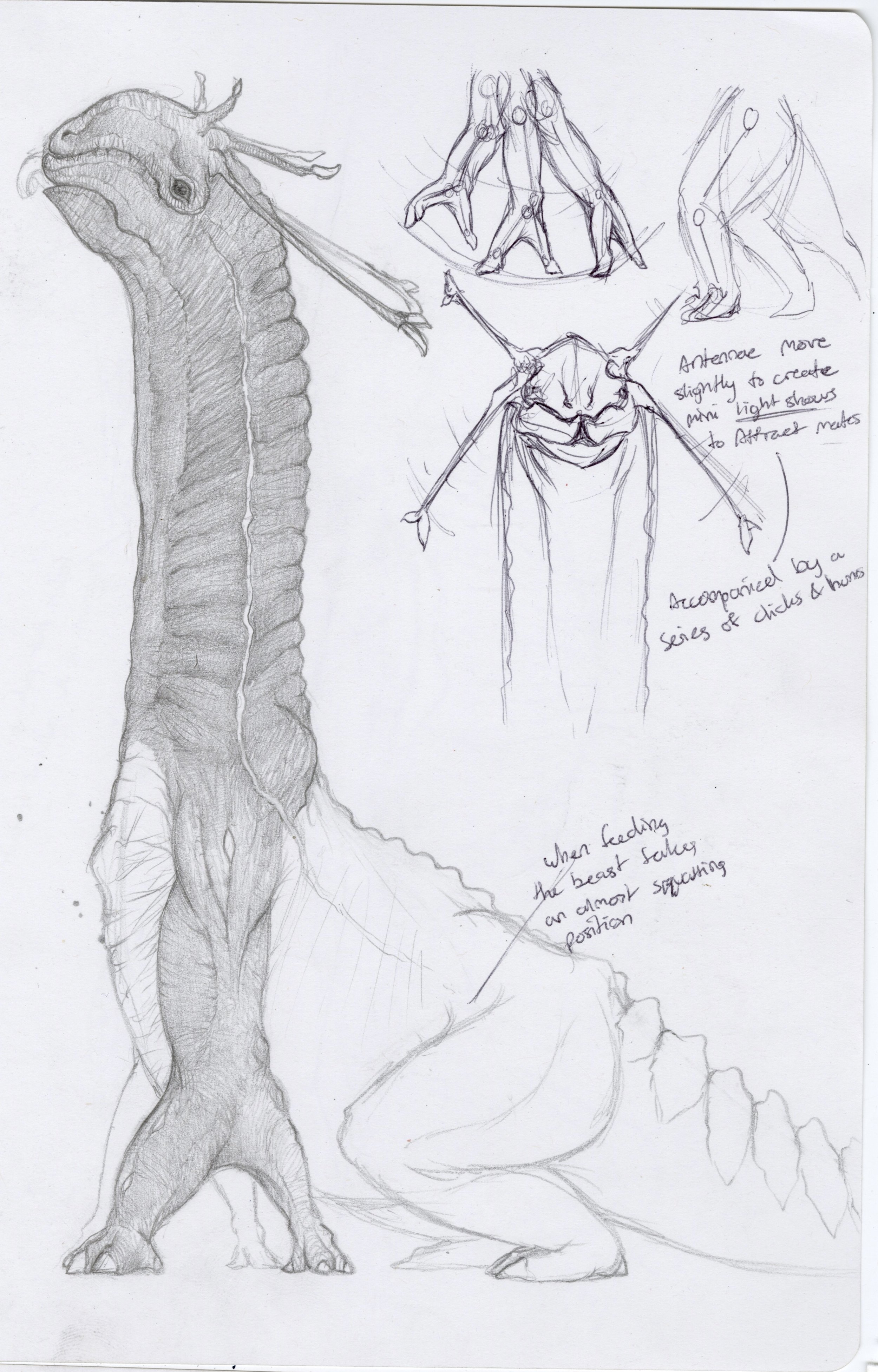
Piece 2: Turrim Bestia
18” x 24” Digital Infographic
Infographic Texts:
These creatures contest for the largest terrestrial animals on Vita. Averaging at 16 meters tall, and nearly 32 metric tons, the Turrim are the definition of “gentle giants.” However, do not mistake their docile nature to mean they are harmless.. Turrim are capable of dangerous acts of self defense.
Their large, bony plated tail has impressive flexibility, allowing them to use it as a spiked club with terrifying force. If a Turrim feels threatened, not only do they assume a defensive position and display their menacing tail, but their array of colorful bioluminescence shifts to an alarming violet (fig.1).
This contrasts the normally warmer yellow color they show when going about their day to day lives. Or, when they are performing mating rituals, the color shifts to a lime green (fig. 2).
The complexities of bioluminescence has developed for a vast majority of animals in this world, especially in the Mycelial Forest. In this biome, sunlight is scarce, and in some cases nonexistent. Theoretically, the evolution of eyesight should be stunted, but not here. Quite the opposite. The Turrim and many other animals have developed complex eyesight and the ability to produce colorful lights streamlined underneath their translucent skin.
The displays of this bioluminescence are mesmerizing, underneath the canopy becomes an array of chromatic excellence.
Like many creatures native to the mycelial forest, the Turrim have developed a complex respiratory system. The nostrils filter out deadly spores that are potent in the air, making the Turrim immune to infection from the fungi.
The Turrim young are born live. They have softer features and lack the bony plates on their tail. This defense mechanism doesn’t develop until a few months into their adolescence. This means they require careful supervision by the parents until they are fit for survival on their own.
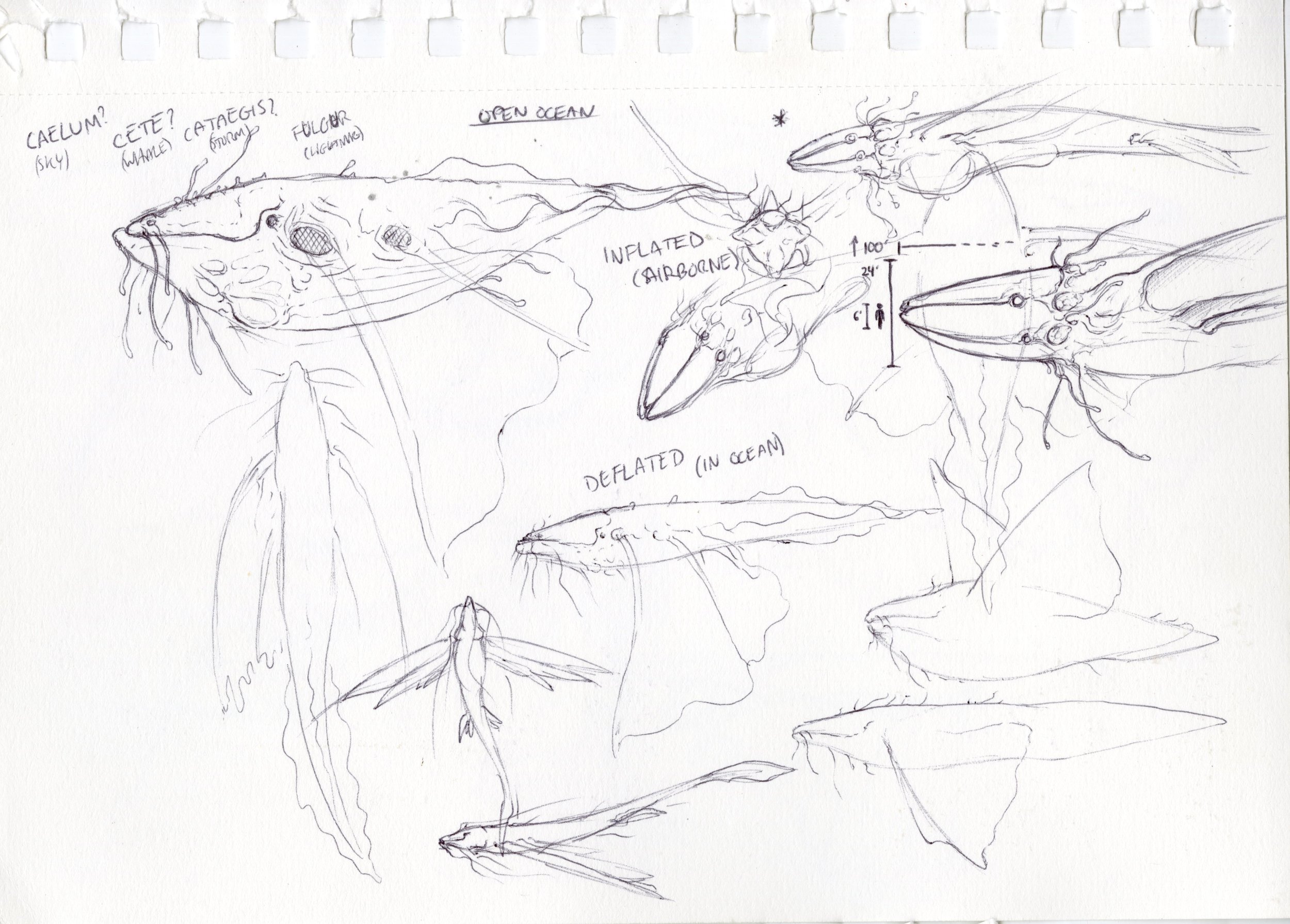
Piece 3: Caesar Leviathan
18” x 24” Digital Infographic
Infographic Texts:
One of the largest species ever recorded, the Caesar Leviathan, can reach lengths of up to 30 meters and weigh nearly 120 metric tons. What is most remarkable about this gargantuan sea serpent is its ability to reach the clouds. The air bladders and large wing-like fins allow the Caesar to launch itself far above the ocean’s surface and glide for a substantial amount of time. The air bladders under its “wings” fill with a naturally produced gas, akin to helium on earth, the gas is much lighter than that of the atmosphere on Vita.
This aids the leviathans to reach never before seen altitudes for a marine species. However, the creature doesn’t soar without purpose.
Caesar Leviathans take to the skies to essentially recharge their amp organs (fig. 1). Whenever a storm begins to take shape over the open ocean, Caesars dive deeper into the ocean to prepare for their powerful leap into the atmosphere. As the storms pursue the leviathan will launch itself out of the water, open its wings, and inflate its air bladders.
As it glides through the storm clouds, its tendrils become the contact points for intense bolts of electricity spawned from the tempest.
These unique tendril-like organs are essential for the Caesar Leviathan. They store seawater and attract electricity in the form of lightning from tempests that spawn over the oceans. The leviathan then uses this stored electricity to stun its prey, making it easier to catch.
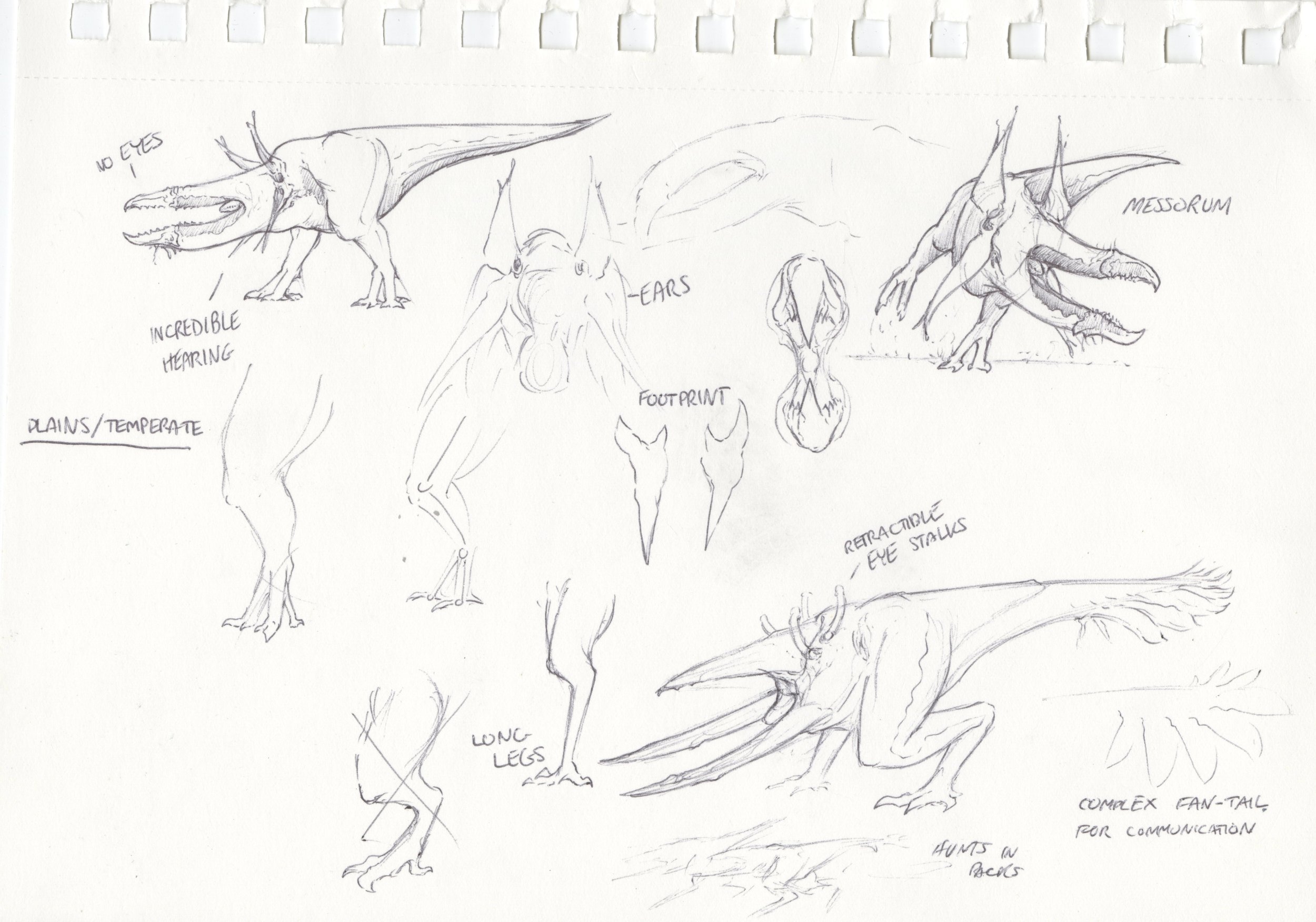
Piece 4: Messorum
18” x 24” Digital Infographic
Infographic Texts:
The Messorum, meaning “Reaper,” was named after its two scythe-like beaks it uses for capturing prey. Each beak is at the end of a separate neck which can move independently from the other. These beaks and necks act as massively powerful jaws that can pick up and hold larger prey for the predator’s beaked tongue to dig into. To find its prey, the Messorum uses its keen hearing abilities. The four yellowish appendages on the creature’s body are ears able to rotate and direct even the quietest of sounds into its highly developed ear canals. The Messorum will hunt any animal smaller than it, sometimes even other Messorum.
Once the beast hears its prey, it uses its muscular legs to chase them down, very few can outrun it.
These deadly creatures inhabit the Shimmergrass Plains, a vast and lush grassland. The tall grass that blankets the biome is iridescent, constantly reflecting reds, blues, and greens with every gust of wind. Most animals living here have bright color patterns. Some using the same iridescent reflections as forms of communication. The Messorum have tail feathers that use this exact coloration to communicate between each other. Despite relying on acute hearing, the
reapers still have eyes that they use for communication. However, they don’t always cooperate. The males tend to get into fights which typically end with one of them being killed and eaten.
The Messorum have evolved to rely on acute hearing rather than a sharp eye. They’ve developed large ears that can rotate and detect even the subtlest of sound waves. This makes the predators very difficult to escape.
The sharp barbs protruding from the Messorum’s necks aren’t technically teeth. They’re in fact vertebrae that have grown more pointed and help the creature hold its prey.
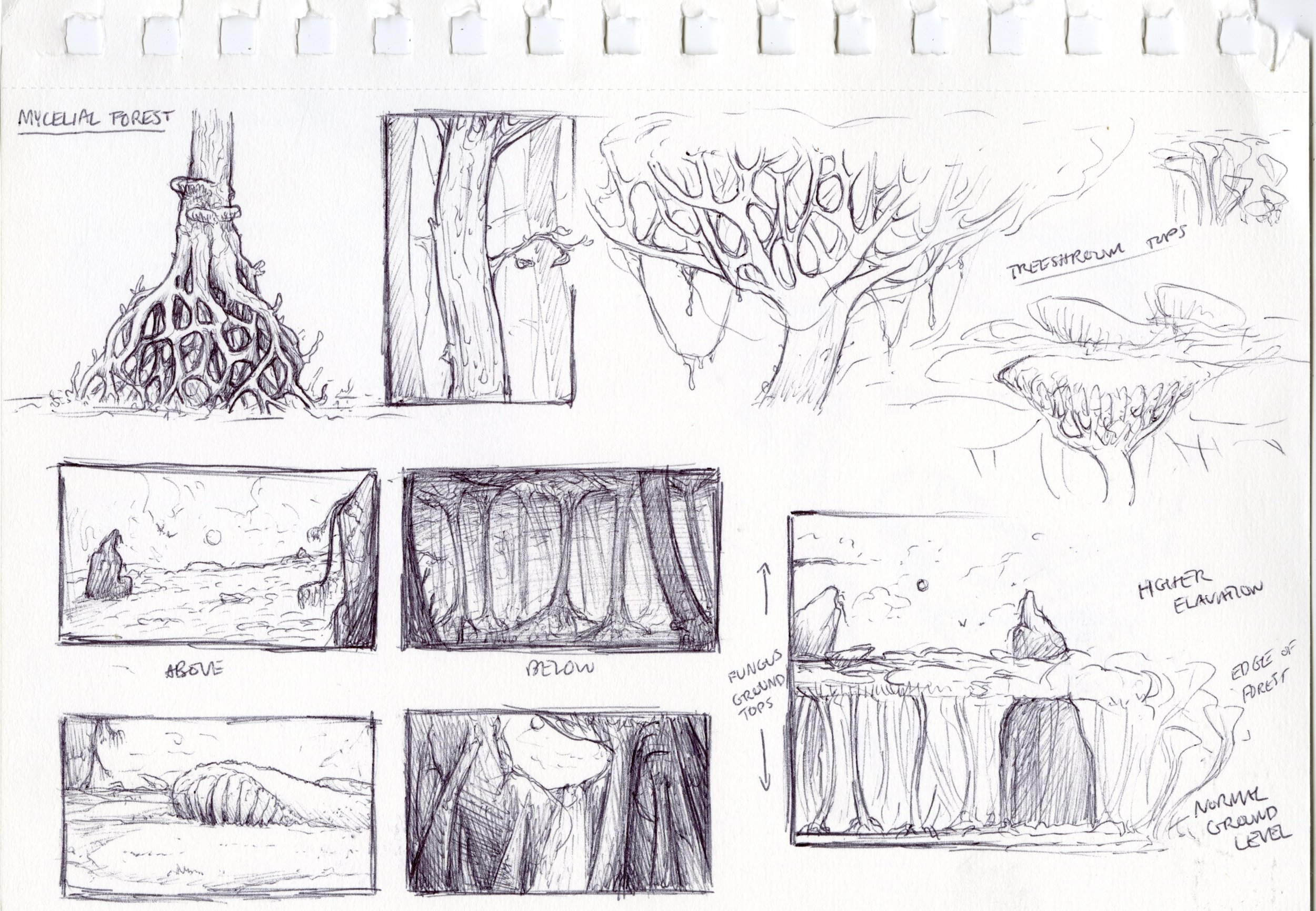
Piece 5: The Mycelial Forest
18” x 24” Digital Infographic
Infographic Texts:
One of the most bizarre yet stunning biomes on Vita is the Mycelial Forest. Home to two wildly different ecosystems, one reaching mountainous heights in the clouds, the other dark, dank and teeming with incredible life (fig. 1). In both the under layer and upper layer monolithic structures jut out of the ground. These “rocks” are actually a form of calcified flora which carry liquid nutrients from the forest floor all the way to the canopy. The monoliths have pores that release the mineral-rich liquid for plants and animals to indulge in. This is why there's an abundance of flora populating the areas surrounding the monoliths.
The aptly named Canopy Marshlands are made up of thousands of mega-flora fungus called arbor mushrooms. The caps of these tree-sized mushrooms are so densely packed they fuse together. This creates a remarkable environment completely separate from the undersides of the mushroom caps.
This is the Canopy Marshlands, a bulbous spongy layer of “ground” with pools of collected rainwater. The ground is almost entirely covered in a soft red moss, giving the aesthetic of rolling crimson hills. Despite the higher elevations here, plenty of life thrives in the clouds.
What also makes the Mycelial Forest so incredible, is the totally different world below the canopy. The Lumous Jungle is named for its abundance of bioluminescent beings, which evolved due to lack of sunlight.
Don’t be fooled by its beauty, the Mycelial Forest has a haunting secret. The arbor mushrooms thrive off of other organic matter, making them carnivorous. The placement of the Mycelial Forest acts as a method of natural selection. The forest is on one of the only terrestrial ways of travel from one continent to another, a “land bridge.” This bridge is a crucial part of hundreds of species’ migration patterns.
Unfortunately for those animals, they haven’t adapted to the unique environment of the Mycelial Forest. The spores of the arbor mushrooms are deadly to those without the proper adaptations. Once inhaled or ingested, the spores travel through the bloodstream to the brain of its victims. When it reaches the brain the parasitic spores force the animal into a moth-like state, making it highly sensitive, yet attracted to sunlight. After days, or even weeks, of being a plant zombie, the animals will find a patch of sunlight either in the forest or on the edge, and wait to die. From the corpse of the unlucky animal sprouts a new arbor mushroom. And so the forest grows.
The mega-flora in the Mycelial Forest are a form of mushroom. The bases of the “trees'' house large vents that pump out hyper-condensed clouds of spores. These spores travel long distances throughout the jungle floor, even reaching the outermost edges of the forest’s influence.
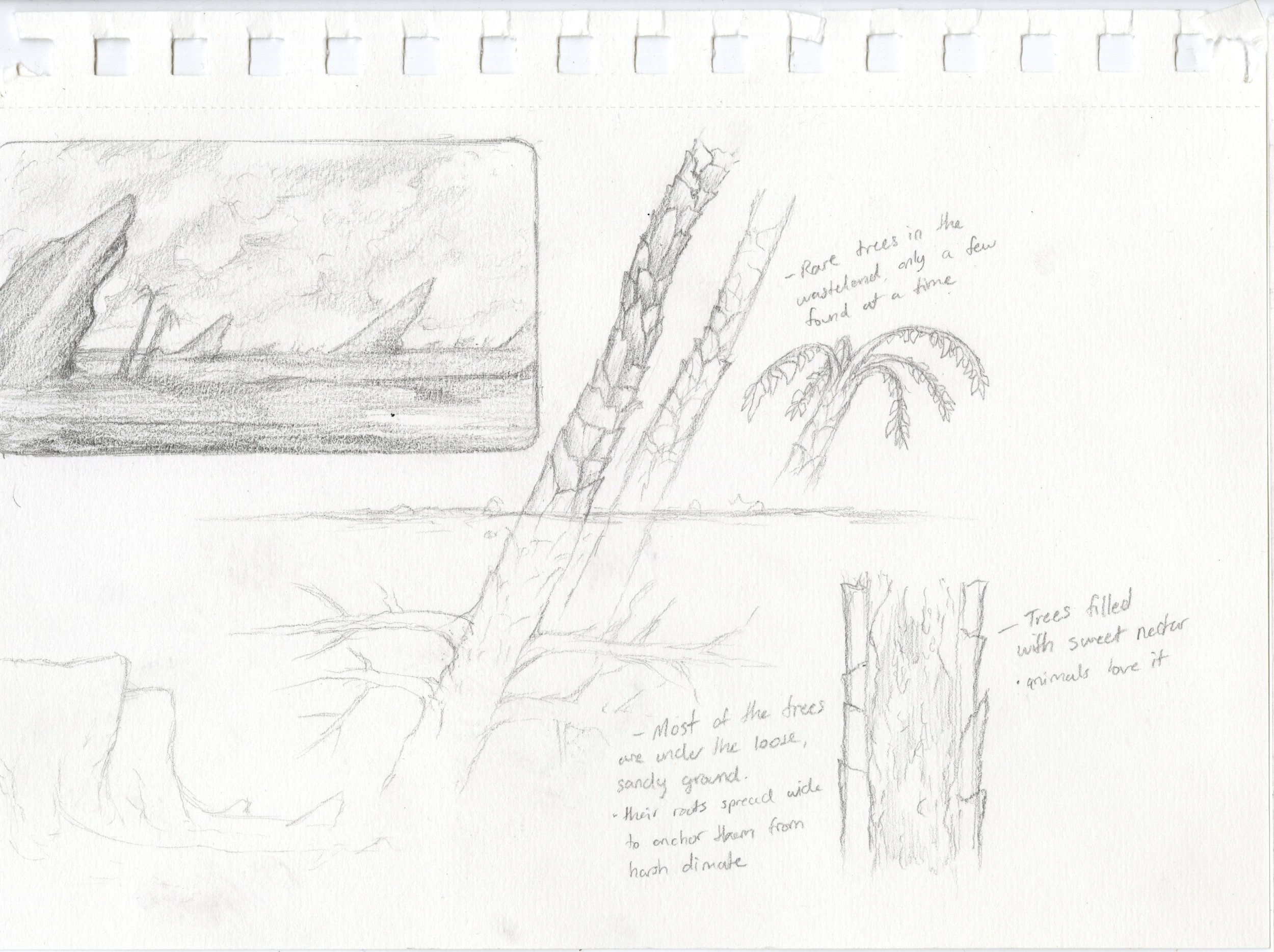
Piece 6: Spire Sands|Sulfur Oasis
18” x 24” Digital Infographic
Infographic Texts:
The Spire Sands, also home to the Sulfur Oasis, is one of the harshest environments on the planet. Due to the planet’s irregularities in its orbit and axis, this biome experiences extreme heat and perpetual daylight throughout most of the year. The climate can get difficult to endure, even for native creatures, forcing them to seek shade wherever they can find it (fig. 2). However, for a brief time during the planet’s annual orbit, the Spire Sands experiences a drastic change in temperature. This is referred to as the “Black Winter” (fig. 1), when the desert becomes cooler and no sunlight will appear. This lasts for what equates to about 3 months back on Terra, and allows for other unique organisms to rise for the short duration.
Despite its name, the Sulfur Oasis isn’t much of an oasis at all. The miniature biome is quite deadly, and combined with the intense heat of the surrounding desert, very few species thrive here. What does survive here must endure the toxic gases that plume off of the blue lava pools. The deep blue color of the lava is caused by the high concentration of sulfur deposits in this area. The second most prominent mineral is a magnetic crystal. These crystals typically form over the course of the long and dry sunny season. As the temperatures drop with the arrival of the Black Winter, the crystals begin to fragment. Small pieces become brittle and their polarity changes, causing the magnetic properties of the mineral to show off.
This is an odd, and almost mystical sight to behold as hundreds of pieces of shiny black rocks will hover just above the mineral-rich ground.
The needle trees are the primary flora located in the Spire Sands. The majority of the plant is embedded deep into the sands to help hold it in place. The cluster of needle-like branches protruding from the top are what produce the trees’ seeds. These seed spikes fall from the tree over time or when the tree is hit or shaken with force. If a needle falls and kills an animal by impaling it, the seed will use the nutrients and liquids from the unlucky creature as fuel to grow.






